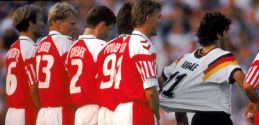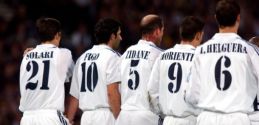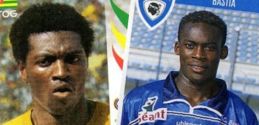
A fateful flight
by Dan Mobbs
“This plane will kill us one day.”
It was said with an air of gallows humour by members of the Zambia squad in early 1993 according to Kalusha Bwalya, but little did PSV’s star striker know that the prediction would become a reality for five crew and 25 staff and players on 27 April 1993.
The Zambian national team were on their way to play Senegal for a 1994 World Cup qualifier in an aging DHC-5D Buffalo plane, when, minutes after taking off following a fuel stop in Gabon, the plane lost altitude and struck the water 500m offshore with a dramatic, bright and fiery light.
It had been a busy week, and Zambia’s trip to play Mauritius in a Nations Cup qualifier in the week before the game added to the strain on a creaking plane and an increasingly tired pilot, Feston M’hone. The Zambian football association (FAZ) had been hoping a wealthy fan would charter a passenger plane for the trip to the idylicc holiday destination in the Indian Ocean, but due to a lack of funds they instead had to request a military aircraft from the Zambian Air Force.
Due to its short haul specifications the Buffalo they were given had to refuel in Lilongwe, but after taking off it was ordered to turn back. Worse lay ahead, as Madagascar had closed its airport for the night and the players ended up sleeping on the Buffalo in Malawi. The game itself was considerably less eventful as Zambia won 3-0 thanks to a Kelvin Mutale hat-trick.
M’hone piloted the 1,957mile journey back to Lusaka and the next day was in the cockpit again for the 5,758mile journey from the Zambian capital. The flight was scheduled to make three refuelling stops; the first at Brazzaville, Congo, the second at Libreville, Gabon, and the third at Abidjan in Ivory Coast, before arriving at their destination in Dakar.
The creaking plane was a popular topic of conversation among the squad and hat-trick hero, Mutale, who told travelling journalist, Beauty Lupiya his concerns aboard the plane, as recounted in The Story of African Football by Ian Hawkey. “You know, Beauty, even if we were to crash, this plane floats. We could survive. They keep life jackets on board. We’d have a good chance of surviving.”
Mutale’s concerns were justified as the 18-year-old plane had not flown since 21 December 1992. As a result test flights were carried out on 22 April and 26 April, and following a series of checks, certain defects were revealed, including carbon particles in the engine and gearbox oil filters, as well as disconnected or unbridled cables. Despite this, the plane’s captain, Feston M’hone made the fateful decision that the flight would still go ahead.
As so many times before there was a delay after refuelling, this time at Libreville, as the military craft was initially denied permission to cross Congolese air space. The plane eventually took-off at 22:44 hours, one hour and 45 minutes late, but shortly afterwards the left engine failed. The plane headed out over sea and lost altitude until it struck the water 500m offshore.
Rumour and suggestion surrounded the actual cause of the crash in the following years, as ministers from Gabon and Zambia squabbled over who would pay for the investigation. A report conducted by the Gabonese Ministry of Defence eventually suggested that the pilot accidentally shut down the remaining right-hand engine causing the plane to lose all power.
An official report was finally released in November 2003 and blamed a mechanical fault in the left engine. The report said that the pilots reacted, but switched off the still functioning right engine by mistake because of a “poor indicator light bulb” causing the plane to lose all power and crash. It also stated that the pilot was tired after flying back from Mauritius the previous day.
President Frederick Chiluba declared a week of national mourning for a team that was fast becoming one of its most successful.
A win over Senegal would have given Chipolopolo (The Copper Bullets) a strong chance of qualification for their first ever World Cup and emphasise Zambia’s growing pedigree. Domestically, Nkana Red Devils had reached the African Champions Cup final in 1990 and the impressively named Power Rangers won the African Cup-Winners’ Cup the following year, but it was in 1988 that Zambia first grabbed the headlines after thrashing Italy at the 1988 Seoul Olympics.
Zambia would lose 4-0 to West Germany in the quarter-finals thanks to a Jurgen Klinsmann hat-trick, but the 4-0 humbling of Francesco Rocca’s side, against a team that included Andrea Carnevale, Luigi De Agostini, Ciro Ferrara, Massimo Crippa and Mauro Tassotti was a reflection of their growth. Charles Musonda started that game in Gwangju, but a persistent knee injury that would eventually end his career, would also save his life.
“One day, during training, during the time of Aad Mos [Musonda’s former manager at Anderlecht], I felt a pain in the right knee. I hurt myself stupidly, as they say, all alone,” he told Belgian sports paper DH.be.
“At first I thought it was okay. I tried to tame the pain for a few months. Big error. I waited too long, I forced, and that was the catastrophe: in total, I was operated seven times in the same knee between 1991 and 1996.
“In 1993, I was on my hospital bed in Antwerp when I learned that all my friends on the national team had perished in an airplane crash. Without this operation, I had to be with them.”
Musonda was one of a small group of European-based players who missed that fateful flight on 27 April 1993. Kalusha Bwalya (below) also didn’t make the trip under pressure from his club, PSV, and instead planned to join the team in Dakar so that he wouldn’t miss too much of his club’s important end of season title chase with Feyenoord.
Tragically, six members of the 1988 Olympic squad, including the goalkeeper and Zambia’s most capped player with 115 full appearances, Efford Chabala (below in the black and white picture), died. So too did the 19-year-old Moses Chikwalakwala, Zambia’s Young Player of the Year in 1992, along with 18 other players and five staff, including manager and Chipolopolo icon, Godfrey Chitalu.
He was a hero of Zambian football. Not only was he voted Zambian Footballer of the Year five times, but the Zambian Football Association claimed Chitalu (in the colour image on the right) scored 107 goals for club and country in 1972, sweeping aside Lionel Messi’s world record of 86 goals in 2012, although this has been disputed.
Chitalu had been appointed manager of Zambia after Samuel Ndhlovu was sacked and ill health meant Moses Simwala had to step aside. He started well and enjoyed a record of four wins, a draw and one loss with 13 goals scored and three conceded, as Zambia pushed to qualify for their first ever World Cup in 1994.

They would be denied this opportunity, but despite the tragedy, Zambia managed to regroup. Spearheaded by Sunderland’s 1973 FA Cup hero Ian Porterfierld and forward, Kalusha Bwalya, the Chipolopolo defied the odds to reach the 1994 African Cup of Nations final and when Elijah Litana gave Zambia the lead after four minutes it looked as if the fairy tale could become a reality. But, two goals from Emmanuel Amunike dashed those hopes and subjected Zambia to a 2-1 defeat at the hands of Nigeria in Tunis.
“Even though we lost that game, I have fond memories because we had just come out of the Gabon tragedy,” Bwalya told BBC Sport in 2010. “After losing the entire team, we started to rebuild and getting to the final was a great achievement.
“I still remember that match like it happened yesterday because of the circumstances surrounding it, and we also played against a very good Nigerian side. We played some of the best football in Zambia’s history in the second half of the match.”
However, 18 years later Zambia were handed an emotional tribute to the 30 people that lost their lives 25 years ago, when Herve Renard’s side reached the 2012 Africa Cup of Nations in final at the Stade d’Angondjé, Libreveille – just miles from the 1993 crash site.
Kalusha Bwalya led the tributes on the day of the final in his capacity as president of the Football Association of Zambia, as players and staff paid their respect. “I’m sure the boys up there will be watching on Sunday,” he said on the morning of the final.
If the 30 were indeed watching then they would have been delighted to see Zambia win 8-7 on penalties against Ivory Coast thanks to Stoppila Sunzu’s winning spot kick, after a tense and goalless 120 minutes.
“I said to the players that a team of ‘replacements’ took Zambia to the final in 1994, so why not us?” said Renard, who had a spell as manager of Cambridge United in 2004. “We always believed and said this was our time.
“We wanted to honour the dead players and that strengthened us. Our first game (in this year’s tournament) was against Senegal and the team was on its way to Senegal for a match when the plane crashed. The plane crashed in Gabon and we won the final in Gabon.
“It was a sign of destiny, written in the sky. There was a force with us. I think God has helped us and given us strength.”
Image: Wikimedia Commons / Times of Zambia newspaper Image: Wikimedia Commons / Times of Zambia library
Tags: Africa Cup of Nations, World Cup, ZambiaShare this article
Leave a comment
- When did co-commentary become such a serious and miserable business?
- Why do we devote so much time to sharing our love of football for free?
- Villa’s Tokyo downfall: The apparent formality of a world title match
- Son Heung-min and the forgotten wonder goals
- Guess the Premier League goalscorer from the GIF
- A fateful flight
- Goodbye to the instant analogue gratification of Ceefax
- Player Profile: Steve Ogrizovic
- Rejecting FA Cup money in favour of a car boot sale
- It’s a man’s world? Former Arsenal manager crosses the gender divide











